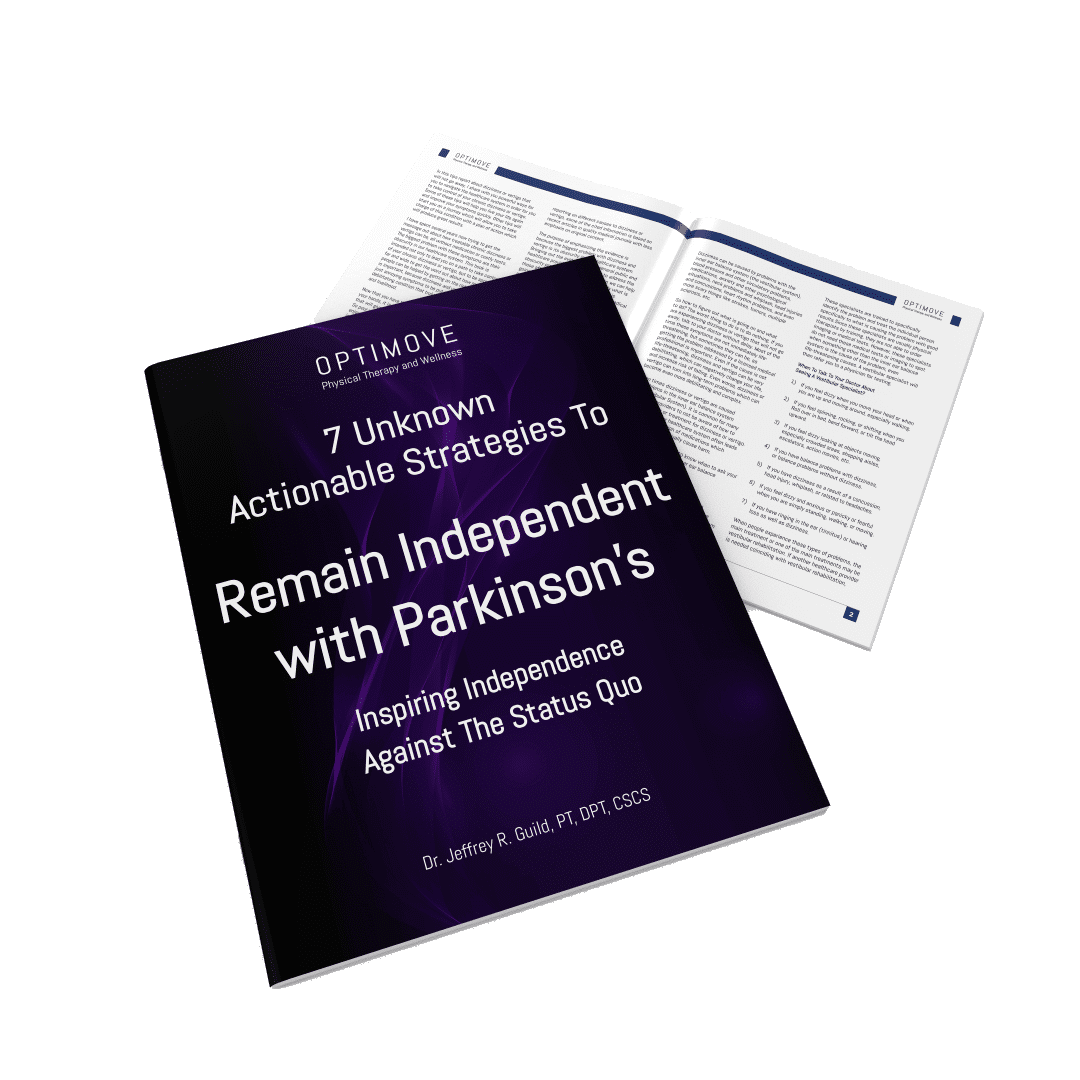In this podcast episode, Dr. Jeffrey Guild discusses common reasons why aging loved ones may have difficulty standing up from a chair.
He explains that mechanical issues, fear of falling, and the chair itself can all affect a person’s ability to stand up properly.
Dr. Guild emphasizes the importance of strengthening the quadriceps, glutes, and back muscles and suggests simple exercises like standing up from a chair as a good starting point.
He also stresses the importance of getting enough repetitions throughout the day and not allowing oneself to become too sedentary in order to maintain strength and independence.
With this information, listeners can better understand the factors that contribute to difficulty standing up from a chair and take steps to improve their loved ones’ mobility and overall health.
Do you or an aging loved one struggle with balance and falls? There is hope. Let us empower you to maintain your independence at home and in the community.
Click the link below to book your free in-home discover visit: https://old.optimovedfw.com/balanceandfallsfb
Speaker 0 (00:00:00) – So what do you do if you’re aging loved? One is having problems setting up Bob a chair. So here are some of the common reasons. One, mechanical and technique is the way that they stand up. Two, the fear of following when they stand up or the fear of going forward when they go to stand up. Three, the chair itself is setting that person up for failure from the get-go. Four, then strength as a possible reasons why they’re having problems. Five, they’re lying back too much so their balance system is conditioned to go backwards rather than forward. And six, not enough reps of actually standing up in the first place. So let’s break this down a little bit. So mechanical is one of the most common causes why people have problems staying up from a chair as they get older. And a lot of times what you’ll see is when someone goes to stand above a chair and they’re struggling, they push more backwards.
Speaker 0 (00:00:46) – And part of this is because one, they stand up from the back of the chair, which is very difficult to do. Ideally we go towards the front of the chair when we go to stand up and young and healthy individuals or older and healthy individuals will just automatically scoot forward to the front of the chair and then they just go to stand up. Now people who are have been struggling for a long time with staying up from a chair will get into this habit of beginning to stand up from the back rather than scooting forward. And this is a common compensation strategy that will often see. Now understand compensation strategies for movement don’t just happen with older people, they happen with younger people as well. And oftentimes I’ll talk about younger individuals to relate it to the older population as well cuz we’re really all not that different.
Speaker 0 (00:01:31) – The main difference is people who have lived a longer life have snowballed a lot of these challenges throughout their life. And if they haven’t been addressed then they tend to become problems. But these problems start when we’re younger. So for example, it’s not uncommon for athletes to actually lose some basic movements that we get as children when we’re growing up. So for instance, when we roll, we should roll on the ground with one body part going one way and then the other part will follow it. It doesn’t roll as a log. Whereas oftentimes toddlers, if they’re developing properly, when they roll on the ground, they will roll not as a log but separately. Sometimes as we get older, an adult, you know, 20 years old, then when we are asked to roll, then we’ll roll as a log. It’s one example of a compensation strategy that can happen to very young adults and even with elite athletes.
Speaker 0 (00:02:22) – So that’s just one compensation that starts early in life. So then you can imagine what then happens as we live throughout the years, we get in auto accidents, we develop injuries, we go through medical complexities and we become weaker in general and our bodies change over time. And if we’re not exercising and work on flexibility and strength and all this stuff, then all these problems can accumulate over the decades. And what then will happen is these compensation strategies will begin to snowball. So then something very basic and more every day, such as staying up from a chair becomes problematic because people develop compensation strategies for this. So one of these common compensation strategies is standing up from the back of the chair rather than scooting forward. So when we stand up, then we’ll press our legs into the chair to help leverage us to stand up rather than scooting forward.
Speaker 0 (00:03:10) – And then using our thigh muscles to stand up. Reason for this is because of the weakness that’s already happened to begin with. Now another mechanical compensation is pushing backwards when we go to stand up rather than going forward. And this feeds into another reason why people tend to struggle is also the fear of falling or the fear of standing up and then being able to catch our balance. So oftentimes when people stand up and they’re struggling with it, they will stand up more through their heels, they’ll put their weight into their heels as they go to stand up and this puts their weight more back. What we actually want is actually for a way to go more forward. It’s not like doing squats when you were in high school, you know with the football team or volleyball team or whatever you did, you know, squat through your heels.
Speaker 0 (00:03:54) – Real life is actually a little bit different. We actually want to shift our weight more forward onto our foot as we go to stand up. And we tend to do this naturally unless if we’re struggling to do it and then the weight tends to go more back and then our weight is already back on our heels and then we tend to fall backwards into the chair. So you might notice if you have an aging loved one, aging parent and they’re struggling to stand up from the chair, usually they’ll fall more backwards rather than falling forward. Now of course there’s exceptions to this and with all this, you want to talk to your doctor, you wanna talk to a physical therapist and find out why and find the solutions. You don’t want to train this on your own in the comfort and safety of your own home.
Speaker 0 (00:04:32) – You wanna get to a professional to deal with this. Now if the person’s going backwards, then that’s gonna make them tend to fall backwards. So then they’ll compensate in other ways. They’ll may depend on a walker, they might pull themselves up from a table to help them stand up. They might always be reaching for something else in order to get themselves more forward as they go to stand up. These are all compensations that tend to happen with adults as we get older. And again, they start early in life. It this is not just older individuals, this starts early in life and this is all of us. The second reason, the fear of falling is a common reason why people can struggle to stand up. So when we go to stand up, we need to be able to shift going from standing up to balancing ourselves before we walk forward.
Speaker 0 (00:05:16) – We can’t just stand up and think that’s all that there is. And that’s why like strength is just one component of standing up from a chair. It’s not all about the leg strength, it’s mostly about these other things, the mechanical reasons. It’s the mindset, it’s the fear of falling. It’s the fact that we’re sitting down too much or recline back too much in the chair. It’s the chair itself that setting us up for failure. So you’ll notice that this chair is a very modern looking chair. You’ll find problems with modern looking chairs. They look very nice and they’re ver all very well and good if you don’t have a problem saying it from a chair, but you notice how it puts me kind of more back and into this position like this. And then when I, even when I lean forward, I’m kind
Speaker 1 (00:05:56) – Of of back and I’m sunken it in into the chair. So that’s problematic when we try to go to stand up. So then even if I scoot forward, it’s kind of low and soft. So I have to really think about it and use a lot of mechanical leverage and a lot of light strength in order to stand up properly. Now what if we change the chair and that’s the only thing that we do. So this chair is a very classic chair and it’s very sturdy. Now it’s actually about the same high as the first chair that we looked at, but it’s not a modern chair. And it gives us more support and then it puts us in a better mechanical position to stand up. We’re not sinky into it, we’re more upright when we’re in this chair. So the chair itself can make a big difference on a person’s ability to stand up properly.
Speaker 1 (00:06:41) – And these things tend to feed into themselves. So what you often find is if you have an older person who’s sitting in a low soft chair or a modern chair, when you’re setting them up for a mechanical disadvantage, then that will feed into the behavior that tends to be problematic. So back to our modern chair, if we’re sunken in already and it’s difficult to scoot forward, then as we go try to stand up, then we tend to just go backwards and it’s much more and more difficult to stand up. And then that feeds into another challenge, which is light strength in and of itself. It makes standing up more difficult. And that decreases the number of times that an older person might stand up from a chair, decreases the number of reps, the number of times that they’ll just get up and walk around. They might ask somebody else to do it instead.
Speaker 1 (00:07:28) – Or they’ll just be more prone to just be less active and move around less and then just stay seated in the chair if it becomes more difficult to stand up. And a big thing you could do again, is the chair of itself, setting the person up for success to be able to stand up and move on with their life. So if we’re in a better mechanical position to stand up, then we’re here and then we’re able to go. We build strength in our legs, we stand up on our own more often and things snowball the positive direction of building life strength of increasing independence with mobility instead of decreasing independence where leg strength decreases, our mechanical advantage decreases, we begin to move differently. A, we don’t get up as often. And so then the number of repetitions that we do throughout the day then slowly decreases.
Speaker 1 (00:08:13) – And this is why people tend to just slowly decline. It’s these small things that can make a big difference. Of course, the obvious answer is leg strength. So what you could do of course, is what can you do to strengthen the person’s quadriceps, their thigh muscles? And what that does, it allows them to develop out the strength to build, to straighten out their knees. But of course it’s not all about the thigh muscles. You also want to strengthen the glutes and the back, so the rear end muscles. And that helps a person to be able to lift their bottom up from the chair. Because what the rear end muscles do is basically push the hip forward. Now you can focus on the hamstrings. I don’t tend to do that as much cuz usually the hamstrings take care of themselves. If you work
Speaker 2 (00:08:54) – On strengthening the glitz, usually the hamstrings will take care of themselves. So it’s focused on the quadriceps and the front, the front, the thigh muscles as well as the rear end muscles in the back that help to push the hip forward. And of course, strength training doesn’t have to be rocket science. Simple things like a progression of standing up from a chair and doing that on a regular basis can be very, very helpful. So a good progression with that is to start with the hands on the chair like this and to be able to do this as many times as you can every single day. And then the progression from there is hand on the thigh. And again, you wanna make sure that the proper mechanics are being used, that they’re not pushing their legs into the chair. You wanna make sure that the person’s not pushing backwards, that they’re going forward and then standing up, put a walker in front of them if you need to, if they use one.
Speaker 2 (00:09:43) – But that’s not everybody. Now, of course, then the next way to increase resistance is to have your hands free and to build able to stand up like that. And that’s the most amount of resistance aside from a course, actually adding resistance, dumbbells and kettlebells and whatever else you want to use. Poor resistance. And that’s very easy to do to add when saying up from a chair. But again, if you’re gonna work on this, talk to a doctor, talk to a physical therapist and make sure that you get the professional help before you do this at home on your own. Now another common cause is when people are just lying on their back too much. It can be when they go out to the hospital and they’re in there for a long time. It can be if they’re just lying back at home more often, especially recliners that people are putting their balance system more in a recline position rather than an upright position.
Speaker 2 (00:10:28) – And what that does, it trains the brain to think, okay, up is actually backwards. So then when people go to stand up, even given all the other advantages, they’ll tend to go more backwards rather than forward. And that puts the person at a big disadvantage because their brain itself is not interpreting where up is because they’re pointing backwards more often. And of course, another common cause is just not getting enough reps, not standing up from the chair enough, not getting up for a drink of water, not getting up to get food, not getting up to live life. And so the more that a person sits in the chair and gets up less, the less that they’re using the proper mechanics. And then when they try to go a standup, they use the wrong mechanics. And all those things snowball and feed into each other towards a vicious cycle, downhill towards decline rather than uphill towards better empowerment, independence, strength, power, and all the things that people need to be able to live life effectively.
Speaker 2 (00:11:23) – So what can you do if you know someone who’s having problems standing up from a chair? First talk to your doctor, of course go see a physical therapist. These are things that can be addressed and they can be addressed very quickly. And big impacts can be made simply by changing the mechanical leverage that the person’s viewing simply by changing their techniques, simply by pointing a few of these basic things out. And then that allows the person to be able to stand up more easily, much more quickly. Of course, sometimes it’s not always fast, sometimes it can take longer.
Speaker 3 (00:11:52) – But a good place to start is with your doctor, then with a physical therapist. And then from there, building up that independence and getting into that cycle of progression rather than decline. Now let’s say if you’re not quite there yet and you’re still in a realm of fitness, don’t allow these things to happen. Work on your life strength. Make sure that you are getting above a chair more often throughout the day and you’re living life and you’re not sitting around reclining back because very basic, if you don’t use it, you.






